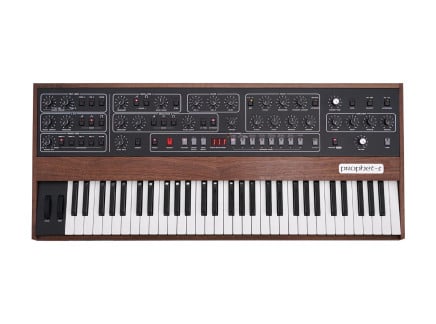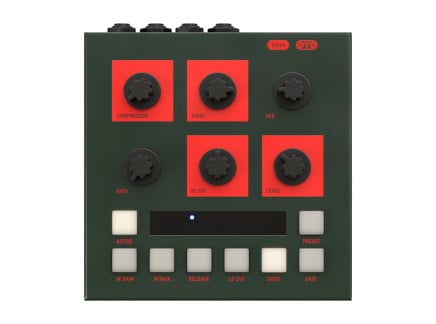Jonathan Snipes is a composer, producer, and performer who has been steadily navigating the complex terrain of the music industry with one hand firmly steering the wheel of film and theater soundtracks, and the other one cutting its own path with a highly unique and flammable take on experimental hip-hop.
Besides being lucky to have Jonathan visit our event space this week with a masterclass on using modular synths and Max/MSP for film scoring, we also had a chance to sit down with him in an interview and talk about his career path, inspirations, clipping, and more.
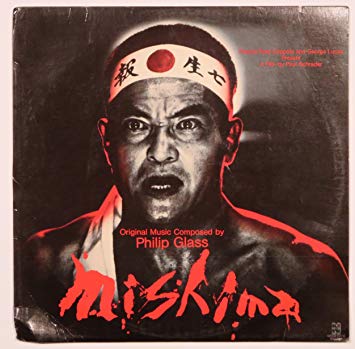
The Path
Eldar Tagi: Hey Jonathan. Thank you for talking to us. To start things off, can you tell us about your background? How did you originally start with music? What and who were your initial inspirations?
Jonathan Snipes: I grew up in a very musical house. My mother played violin, and my father was a huge supporter of opera, even working in the opera company where we lived (Riverside, CA). We always had opera singers staying with us, and I was in a couple of productions as a child. I was always horrible at actually studying music. I was really appalling at practicing, or having any kind of discipline. As a child I studied violin, trumpet, bagpipe, piano, and voice, but never stuck with any of them long enough to actually be proficient at any of those instruments. Computers are really what allowed me to make music. Even as a child I remember being obsessed with electronic music and synthesizers whenever I heard them. We had a very classical house (I wasn’t allowed to listen to pop music or the radio really at all) but my dad had a couple of Wendy Carlos and Don Dorsey records, which I listened to over and over again. He passed away when I was eight years old, so much of my musical education came from digging through his pretty extensive record collection. He had only a pretty small selection of 20th century or avant garde music, but that ended up being my gateway into a lot of music. He had one Philip Glass album (the soundtrack for Paul Schrader’s Mishima) which I became obsessed with, and became my launching point into other things.
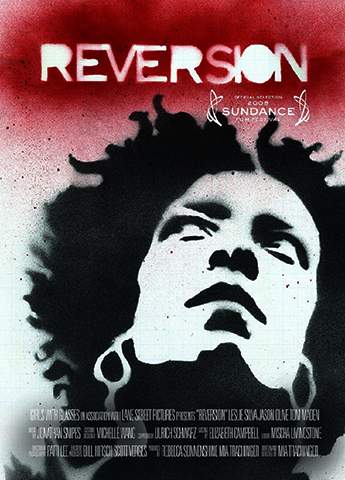
ET: To the best of my knowledge, your music career branched primarily into two directions—film scoring and your work with clipping. I’d like to talk a little bit about both throughout this interview, but let’s start with your soundtrack work. What was the very first film that you scored? How did the project come about?
JS: The first film I scored was a 30-40 minute documentary about the French pornograhpy industry called La Petite Morte. It was made by Emmanuelle Schick, a graduate student at UCLA, where I was an undergraduate theater student. She and I had a class together and she heard that I was making music on my computer, and asked if I wanted to score her film. I did a few short films for other film students after that, and that lead to Mia Trachinger asking me to score Reversion, which was my first feature length project (though it only contains about 15 minutes of score). That film went to Sundance, and I think having that on my resume enabled me to get other work, or at least allowed other producers and directors to trust that I could actually deliver a real score.
ET: Since that initial project what was your process of getting more film scoring work? Were you actively seeking projects or did people start contacting you with offers? What was the path like from the first gig to becoming a full-time composer?
JS: Music was still definitely a hobby for a long time. I went to graduate school for theater sound design, but fell into a few jobs working on some TV shows making electronic sounds (The Sarah Connor Chronicles, Tron: Uprising, etc) as well as some scoring work doing made-for-TV disaster movies. All of this work was through friends. The composer Bear McCreary is a childhood friend, and he started hearing some of the electronic music I was making and thought it’d be fun to collaborate on some film scores. Lawrence Klein, who made a number of music videos for my previous band (Captain Ahab) was working at a TV-movie production house as an editor, and got me on their scoring roster, which is really where I learned how to turn out a finished film score really quickly. All the work I’ve gotten has been from friends or from word of mouth. I’ve never gotten a job I applied for or demoed for.
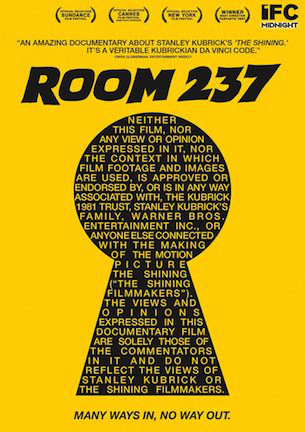
ET: I’ve noticed that a lot of the films you score fit the Horror/Thriller category. Is it your personal preference to work with those genres? I feel that they offer a pretty open framework for a lot of experimental sound design.
JS: Yeah, I love horror movies in my personal life, so I already have a strong relationship with the genre. I love the adventurousness of horror music and sound design. I think I'd be happy to always have my fingers in a horror project. I don’t see it as a stepping stone or feel compelled to try to branch out that much.
ET: You also do a lot of music for theater. How is composing music for theater different from composing for film? Do you prefer one to the other?
JS: More and more I try to use what I learn in one medium & apply it to others. I differentiate less and less beyond the obvious technical distinctions. Theater being site specific changes the kind of music I write for sure. Usually the music & sounds I make for theater only feel like they work in that room on that system in that context. Whereas making music for film is more like making an album. I've never felt like releasing any of my theater music outside of the context of the show, because I have trouble making it feel right. That could just be laziness on my part too. All my formal training and studying is in theater, so that still feels like my first love really. I can't imagine doing only film or only theater though, I really like doing both.

ET: What are the typical challenges you face when scoring? What was the most challenging project so far and why?
JS: Projects are the most challenging when the director and I are having trouble communicating. Usually it comes down to me not understanding what the project is really trying to do. There are some scores that I feel like I’ve never really understood, that I’m just shooting wildly in the dark hoping to hit something the director wants. And then when something works, I have no idea why, but I have to keep grasping for other successes. That’s the hardest. It’s getting rarer and rarer, and it’s usually a sign that I shouldn’t be doing that project at all, but I’m stuck and have to see it through. It generally boils down to communication.
ET: What are your favorite aspects of composing music for film and theater?
JS: I guess the opposite of the above. When everything clicks, and we’re all working on the same piece and really understand each other. Both theater and film are so collaborative, I really have to throw my ego and preciousness about music away and just make the thing that the project wants. I’ve scrapped a lot of cues that I really liked musically just because they weren’t working for whatever reason. I really love being in that zone with a great creative team.
Clipping.

ET: Now, let’s talk about clipping. How did this project come about? All of you (Jonathan Snipes, Daveed Diggs, William Hutson) have known each other since childhood, is that right?
JS: I’ve known those guys for almost 20 years. They have been friends about 10 years longer than that, so I still feel like the new guy, which is a bit ridiculous. Bill and I went to college together, and Daveed would come crash on our couch during the summers or whenever he was on a break and we weren’t. We had made a handful of tracks together over the years. Bill & I had a variety of one-off noise projects. Bill used to have a project with our friend Kyle Mabson called “Beach Balls” that was this pretty silly party noise thing that I loved immensely. One of their releases included a track called “case sensitivity” that I think Bill made on his own. It featured a Yin Yang Twins acapella set over these really punishingly high pitched clicking sounds, and I thought the whole thing was so elegant and beautiful. I kept saying to Bill, “this is a whole genre - you’ve gotta do more of this.” But they were done doing Beach Balls for whatever reason so I said, “Well if you’re not going to do it on your own, let’s do it together as a remix project.” So we started taking existing rap acapellas and making new beats for them in that style. The rules were no drums, no pitched/melodic material, but they still had to be highly composed/rhythmic/intentional - it couldn’t just sound like noise jamming over the acapella. We made a handful of those (I think they’re still on soundcloud) and called the project “clipping” - we played a handful of shows playing those remixes. Around that time Daveed moved to LA and heard what we were up to and said, “you should make an original track, not just a remix.” That song was “Loud” which ended up on the midcity album. I think we did one show at Pehrspace (RIP) where Bill & I played a handful of remixes, then Daveed came out and did “Loud” with us at the end. After that we said, “ohhh, this should be the project. It should all be original songs.” So we made enough for a full set.
ET: While Daveed's contributions to clipping seem pretty transparent, it's not always obvious how your and Will’s roles are distributed? Is each of you responsible for something in particular or is it more fluid?
JS: It’s fairly fluid, though everything happens in my studio. It’s rare that Bill touches the computer anymore, though when we first started we were trading off a bit more. If we’re recording vocals and I have to jump up to take a phone call or something, he’ll run the session for a bit, but usually I’m actually hands-on, and he’s behind me fiddling with modular gear, or just tossing out ideas. There were a few tracks early on that Bill made on his own and we flew them in at my place and just mixed them, or made a couple of tweaks, but that happens less & less. Generally we start things together in my studio at the same time. If it’s Bill’s idea, it starts with a conceptual idea (“What if we made [x] type of rap song with [y] kind of sound?”) and if it’s my idea it usually stems from an aesthetic/sonic idea, or a specific process I think would yield an interesting result. Like it was Bill’s idea to use the Deathpile and Whitehouse samples (Body & Blood, Wriggle) but it was my idea to hear beats coming out of passing cars that line up with Daveed’s rapping in “Run for your Life.” Sometimes I will have made a field recording I like, and I’ll have an idea about how to arrange it musically. Bill will hear that and say, “oh if we add this element, then it will feel like this kind of rap song.” Usually both of these things are happening simultaneously, but sometimes one of us will lead pretty heavily. Occasionally I’ll make an entire beat by myself, and Bill will add one sound or nothing at all - but that’s happening less and less.
ET: The scope of music genres present throughout the band’s albums is truly diverse. I sense references to academic electronic music in “Willams Mix”, industrial and power-electronics in “Loud”, glitch in “Real”, pop hooks in “Get Up”, even traditional folk in “Story 1”. With such a broad range of influences evident from your music, I assume you are constantly discovering something new to obsess over. What music/art/films/books are you into these days?
JS: “Williams Mix” is beyond just a reference to academic electronic music, it’s actually a performance of the John Cage piece of the same name. Tom Erbe made the software to realize the performance, and it’s composed entirely of sounds we’ve recorded and generated, mostly from other clipping songs. What am I into these days? Some of my favorite records of 2019 so far include: Billy Woods/Kenny Segal Hiding Places, Anna Meredith FIBS, Hama Houmeissa, Claire Cronin Big Dread Moon, Megan Thee Stallion Fever, Debby Friday Fatal, Caroline Shaw/Attacca Quartet Orange, Cheryl E. Leonard Watershed, Homemade Weapons Gravity, Pedestrian Deposit Dyers’ Hands, Counterfeit Madison Knucklehead, Bryce Miller Monochrome Daydream, Dis Fantasy Dis Fantasy EP, They Hate Change Juices Run Clear, Hannah Diamond Reflections, Adrian Corker Music for Lock Grooves, Rrose Hymn to Moisture.
ET: This is great. Thank you for clarifying. On the latest clipping record There Existed an Addiction To Blood you also have the track called “Piano Burning” which, I believe is a performance of a piece originally composed by Annea Lockwood? How and where did you record it? What was the intention to close the record with this composition?
JS: Yeah, that was Bill’s idea. We were trying to think of a piece to use that would feel appropriate for the horror theme, and often horror movies end in a fire. It felt cleansing and spooky at the same time, as well as keeping in line with our tradition of ending albums with recordings of specific pieces of contemporary music. We love Annea Lockwood in general, so this really checked all the boxes. We recorded it with Christopher Fleeger (we collaborate with him a LOT) out in the desert at an undisclosed location our friend Cristopher Cichocki found for us. 18 channels across 3 different recorders, timecode locked. It took hours to set up and test everything. We lost eight microphones in the process of recording. Fleeger and I used it as an opportunity to thin out some of the cheaper/crappier mics we owned. It was worth it.
New Record and Creative Constraints

ET: Can you talk about the overall inspiration for There Existed An Addiction To Blood?
JS: We had made the song “Club Down” (in 2014, right before CLPPNG came out) and said, “oh we should make a whole horrorcore record.” So we always knew we were going to do this, even before we started Splendor & Misery, I think. So it’s been a long time coming. We’re all fans of horror movies and horrorcore rap, so it seemed like an obvious choice for us.
ET: When you are working on the material for clipping. does your writing process involve a particular routine or does it always change?
JS: It changes, but has definitely normalized a bit over the past record. More or less always now the beat comes first, and Daveed is writing afterwards, which I guess is a more traditional way of working. We used to sometimes have Daveed write to a click, and then build the beat around that acapella, which I really miss. We should do that again. Usually what happens now is Bill & I sketch out an idea in pretty broad strokes, then figure out with Daveed what kind of song we think it is (sometimes this is obvious from the beginning, sometimes not). Then Daveed writes usually a verse and a hook (if the song has a hook). We record that, and discuss. Then Bill & I clean up the beat & make new sections/choices while Daveed writes verse 2. Then we record that, possibly re-record the first verse, and see where we are. So we pass it back & forth a bit, re-tooling & configuring sections based on what needs to happen with the vocals. “Oh, maybe these verses should be 12 bars instead of 16.” “This song could have a bridge.” Things like that.
ET: I read in one of your interviews that you’ve eliminated the first-person narrative in your lyrics, and one of the ways to achieve that was to take out the word “I”. Are there more invisible rules like this that help in communicating your vision through your work?
JS: We started with quite a few beat making rules too. Initially, we weren’t allowed to use anything that could be thought of as a conventional drum sound, or anything that was at a fixed western pitch. The idea was to create catchy rhythmic tracks out of entirely non-percussive, non-melodic material. The first handful of tracks we made (Loud, Guns Up, Get It, Block, Face) obeyed those rules pretty carefully, but we ended up breaking them almost immediately and just sticking to the spirit of those rules. Obviously there are tons of drums & melodies all over our tracks now, but I think the spirit of the original rules is still alive in most of the songs. Actually one of the tracks on Addiction to Blood started as a beat called “Original Rules” that was an attempt to re-capture some of those earlier tracks by sticking to that very prescriptive way of working. That song became “All in Your Head” which ends in a huge sung melodic section with a live drum set though, so we really fucked that up.
Studio and Gear
ET: Do you have particular go-to pieces of gear or software? What are your absolute essentials for making music?

JS: I try to remain as software-agnostic as possible. We switch between Logic, Pro Tools, and Reaper for production. Many songs also involve Max patches that I’ll make on an “as needed” basis. My studio has a lot of modular gear in it, mostly 5u, but a healthy amount of eurorack and a little frac rack as well. The modulars get a lot of use, as do my Prophet V (rev 2), and Oberheim SEM. I also have an SH101, Original Arp Odyssey, Original Korg MS20, TR808, TR909, Linn Drum, Korg Wavestation, Roland D550, Yamaha TX816, Roland MKS50. Those are all on the new album in one place or another. Thermionic Culture Vulture ends up on almost every track too, but we also use a lot of other distortions. The OTO Boum has gotten a lot of use since I picked that up.
ET: When did you first start working with modular synthesizers and Max/MSP? What do you find particularly attractive in both of these formats?
JS: I learned Max in the context of theater sound design at school. It was the days before QLab, so there wasn’t really a very good computer based non-linear way of controlling sounds for theater. People were still using minidiscs and CDs and Instant Replay machines. Max appealed to me immediately since I had been making music on computers for awhile, but I really didn’t use it for music at first - just for theater. Modular synths seemed like the obvious next step. When I started in 2005-ish there wasn’t that much on the market. Doepfer, Analogue Systems & Solutions were the only players in Eurorack, really, and the look & feel of that stuff didn’t really appeal to me, plus the cases were so expensive. So I got into 5u via Synthesizers.com through their monthly payment program. It took awhile to get enough of a system together that I really wanted to use it on tracks. Probably the first modular I recorded was the Captain Ahab song “Snakes on the Brain” which used my dotcom system for the bassline. I didn’t have a filter yet, so it’s just a straight-up sawtooth wave as I remember.

ET: Do you experience any particular challenges when taking the music you’ve written live? What does your general live setup consist of?
JS: It’s actually changing right now. For years, I’ve been using a monstrous max patch that’s basically a glorified version of Traktor or some other DJ software, but that interacts with the tracks in exactly the way I want. Over time it’s gotten harder and harder to troubleshoot, and is behaving in strange ways that I can’t diagnose. I’ve had a few crashes mid-set, and a lot of weird audio dropouts that never used to happen. Not sure if it’s changes to the MacOS, or what. But consequently I’m in the process of moving everything to Ableton Live, which I’ve been resisting doing for ages, but is actually working out pretty well. Max 4 Live allows me to break Ableton in new and interesting ways every time it doesn’t quite do what I want it to do, and so far I’m pretty much able to replicate all the functionality I want.
ET: Lastly, can you tell us about your plans for the near future. What are you busy with these days? What is the best place for people to follow your work?
JS:I’m doing a handful of films, some shorts & features. I recently scored a movie called Mope that I think will be distributed soon, so that’s probably the next film of mine that will get a release. I try to keep jonat8han.com updated with projects, but it’s hard to keep it current. Theater-wise, I’ve been doing a show for the last year or so with Lars Jan called The White Album based on the Joan Didion essay. I’m immensely proud of it, and it will be showing in Sydney Australia in January 2020. After that I have some plays in LA at the Skirball Cultural Center (On the Other Side, February 2020) and Geffen Playhouse (Macbeth, June 2020).



